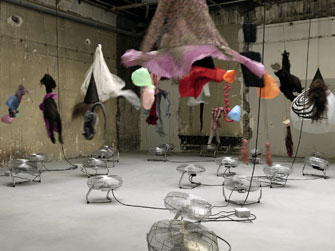Three Times
A Charm

Annette Messager’s “Motion/Emotion” (2012) at La Triennale.
One week after the reopening of the immense spaces of Paris’s cutting-edge contemporary art museum, the Palais de Tokyo, with the show “(Entre)Ouverture,” consisting mostly of large installations, another huge exhibition, “La Triennale: Intense Proximity” has opened there.
This is the third edition of a triennial contemporary art event backed by the French Ministry of Culture, which was called “La Force de l’Art” when it was held at the Grand Palais and limited to artists living or working in France. The name change was a good idea, since the last triennial was a dull event, and so is the opening up to artists from around the world.
The difference was immediately evident in this year’s show, curated by Okwui Enwezor, a Nigerian who runs the Haus der Kunst in Munich. Instead of familiar names presenting already seen works, this exciting show is packed with pieces by artists we haven’t seen much (or any) of in France, allowing for the thrill of discovering new talents.
As far as I can understand the high-flying art-world jargon in the press release, the title “Intense Proximity” has something to do with making connections in our globalized world, but no matter – what counts is the art, by artists young and old (and some dead), which for the most part is excellent.
Some of the highlights were Dominik Lang’s “Sleeping City” (2011), a room filled with sculptures of people that have been dissected, corroded, broken, framed and mirrored; Camille Henrot’s installation of strange flower arrangements, “Is It Possible to Be Revolutionary and Love Flowers?” (2012), all accompanied by a quote from a famous iconoclast, from André Breton to Jean Genet; Victor Man’s dark, mysterious monochrome paintings; Ellen Gallager’s delicate cut-out paintings framed so that both sides can be seen; and Annette Messager’s witty installation “Motion/Emotion” (2012), in which fans on the floor keep objects hanging from the ceiling – a dress, a long wig, a soft sculpture of human guts, etc. – constantly moving.
The wonderful thing about the “renovated” (I use quotes because you couldn’t exactly say these rough, unfinished concrete spaces had been “fixed up” or beautified in any way) and expanded Palais de Tokyo is that it allows for all manner of works to be shown. It’s a refreshingly anarchic counterpart to Paris’s many beautiful, sophisticated museums.
When you leave the Palais de Tokyo, look across the street at the Galliera, the city of Paris’s fashion museum (now closed for renovation), its facade covered with a beautiful silver and brown hanging by El Anatsui. The garden in front of the building is open to the public if you would like a closer look. Several other institutions in and around Paris, including the Louvre and the jazz club Les Instants Chavirés, are also participating in the Triennale. See the Web site for details.
La Triennale: Palais de Tokyo, 13, Avenue du Président Wilson, 75116 Paris. Métro: Alma-Marceau or Iéna. Open noon-midnight. Closed Tuesday. Admission: €8. Through August 26. www.latriennale.org
Reader Barney Kirchhoff writes: “I saw this show the other day. First time in years that I’ve seen lines there.
“There were no lines across the way at the city of Paris’s museum of modern art, perhaps because the main show, on American underground cartoonist R. Crumb, is primarily for English readers. This is just as well, as the show mainly consists of blowups of pages of Crumb’s comic book sequences. The sparse number of visitors gives you the space to actually read them. One large room is devoted solely to his take on Genesis, with all 201 plates. Most of the exhibition is more secular, with some sequences that are XXX.
“This seems to be the season for offbeat art. I also went to the Tim Burton exhibition at the Cinémathèque, which was truly packed, affording little opportunity to examine the hundreds of drawings that make up a major part of the show. The nice part is that you can twin a visit to the exhibition with an afternoon movie but it’s only open until 7 p.m., whereas the Palais de Tokyo is the only museum in Paris (except the sex museum) that stays open every night (except on Tuesday, its closed day) until midnight.”
Reader Reaction: Click here to respond to this article (your response may be published on this page and is subject to editing).
Please support Paris Update by ordering books from Paris Update’s Amazon store at no extra cost. Click on your preferred Amazon location: U.K., France, U.S.
More reviews of Paris art shows.
© 2012 Paris Update
